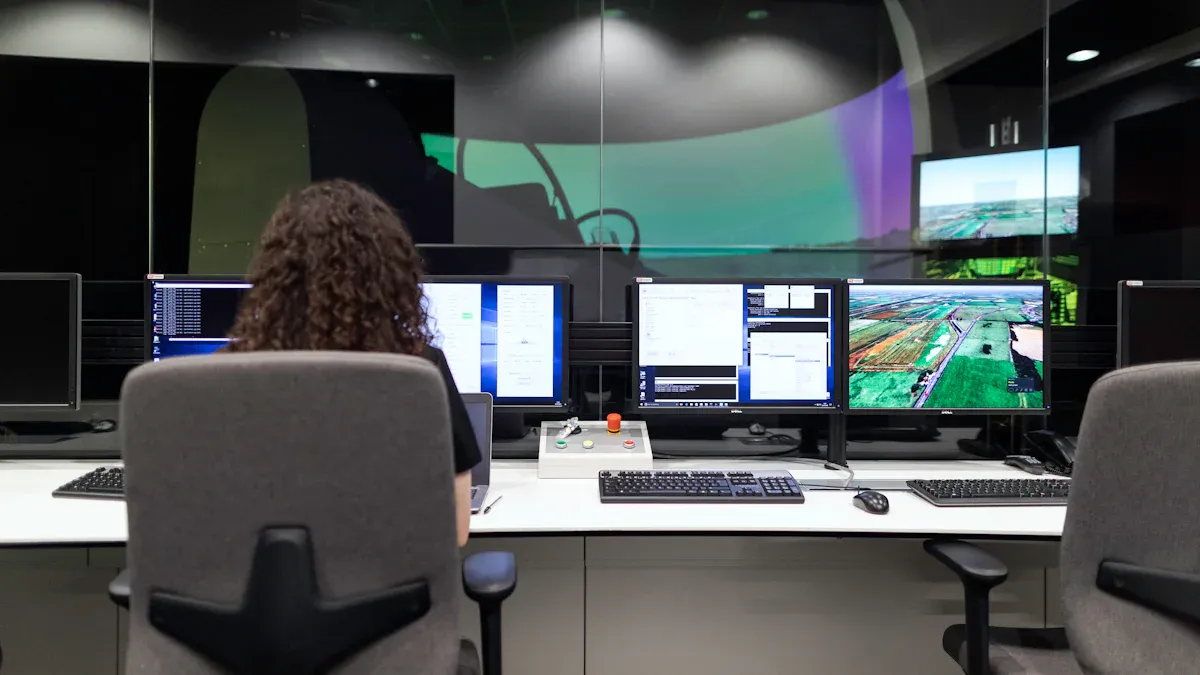The Role of SAT in Machine Vision System Validation

Validating a SAT (Site Acceptance Test) machine vision system requires a thorough process. This final step ensures the machine vision system operates as intended in its real-world environment. You can rely on the SAT to confirm functionality, compliance, and readiness for operation.
- Meticulous planning and setup during the SAT help verify that the machine vision system meets operational standards.
- Documenting results from the SAT ensures compliance with customer requirements and manufacturer specifications.
- Early error detection during the SAT prevents issues from escalating, improving overall readiness.
- Confirming equipment performance through the SAT increases customer satisfaction and trust.
When you perform a SAT for your machine vision system, you guarantee a reliable, compliant, and high-performing system.
Key Takeaways
- Doing a Site Acceptance Test (SAT) makes sure your machine vision system works well in real-life situations.
- Keeping detailed records during SAT shows it follows rules and helps with future fixes.
- Finding mistakes early in SAT stops bigger problems later and makes setup easier.
- Including everyone in the SAT process matches the system to their needs and makes users happier.
- SAT gives customers trust by proving the system works as expected and does what it should.
Understanding SAT in Machine Vision Systems
Definition and Purpose of SAT
A Site Acceptance Test (SAT) ensures that a machine vision system performs as expected in its actual working environment. This process validates the system's ability to meet operational requirements and customer expectations. Machine vision systems combine mechanical, optical, electronic, and software components to inspect objects and processes. These systems detect defects, improve quality, and enhance efficiency. SAT confirms that all these elements work together seamlessly under real-world conditions.
- Advanced cameras and software are tailored for specific inspection tasks.
- Lighting schemes vary depending on the object being inspected, showcasing the system's adaptability.
- These features highlight how SAT ensures the reliability and effectiveness of the inspection process.
By conducting SAT, you verify that the system integrates properly with existing workflows and delivers consistent results.
Key Objectives of SAT in Machine Vision Systems
The primary goal of SAT is to validate the system's readiness for operation. You ensure that the machine vision system meets all functional, performance, and quality requirements. Key objectives include:
- Functionality Testing: Confirm that the system performs its intended tasks, such as detecting defects or measuring dimensions.
- Performance Validation: Assess the system's speed, accuracy, and consistency in real-world conditions.
- Compliance Verification: Ensure the system adheres to industry standards and customer specifications.
- Integration Assessment: Check how well the system integrates with other equipment and processes.
Meeting these objectives guarantees that the system operates efficiently and reliably in its intended environment.
Importance of SAT in Operational Environments
SAT plays a critical role in ensuring the success of machine vision systems in operational settings. When you conduct a thorough SAT, you minimize risks and avoid costly downtime. This process helps identify and resolve potential issues before full-scale deployment. It also builds confidence in the system's ability to deliver high-quality results consistently.
In operational environments, machine vision systems often face challenges like variable lighting, diverse object types, and high-speed production lines. SAT ensures the system can handle these challenges effectively. By validating the system's performance and quality, you enhance its reliability and ensure it meets the demands of real-world applications.
Tip: Always document the SAT process thoroughly. This documentation serves as proof of compliance and provides a reference for future maintenance or upgrades.
Comparing SAT and FAT in System Validation
Overview of FAT (Factory Acceptance Test)
The Factory Acceptance Test (FAT) is an essential step in validating machine vision systems. It takes place at the manufacturer’s site, where you can evaluate the system under controlled conditions. FAT ensures that the equipment meets design specifications and functions as intended before it is shipped to your location. This process also provides an opportunity for early operator training and helps identify potential issues before installation.
During FAT, you can verify the system’s completeness, functionality, and compliance with contractual requirements. It also confirms that the installation site is ready to receive the equipment. By addressing these aspects early, FAT minimizes risks and ensures a smoother transition to the next phase of validation.
Key Differences Between SAT and FAT
Although both FAT and SAT are critical, they serve distinct purposes and occur at different stages. The table below highlights their key differences:
| Aspect | Factory Acceptance Test (FAT) | Site Acceptance Test (SAT) |
|---|---|---|
| Location | Conducted at the system manufacturer’s site | Conducted at the owner representative’s site |
| Environmental Conditions | Controlled conditions at the manufacturer’s site | Real-world conditions at the owner’s site |
| Timing | Conducted before installation of equipment | Conducted after installation at the site |
| Purpose | Verify equipment meets specifications and is functional | Ensure the system operates correctly in the actual environment |
| Focus | Completeness, contractual requirements, functionality | Performance in real-world conditions |
| Training | Operator training begins during FAT | Final training may occur during SAT |
| Installation Requirements | Confirms readiness of installation site | Validates installation and setup |
These differences emphasize how FAT focuses on system readiness at the manufacturer’s site, while SAT ensures the system performs as expected in its operational environment.
Why Both FAT and SAT Are Essential for Machine Vision System Validation
You need both FAT and SAT to ensure a comprehensive validation process. FAT allows you to address issues early, reducing the likelihood of delays or failures during installation. It also provides a controlled environment to test the system’s functionality and train operators.
SAT, on the other hand, validates the system in its actual working environment. This step ensures that the machine vision system integrates seamlessly with existing workflows and performs reliably under real-world conditions. By conducting both tests, you can confirm that the system meets all requirements and delivers consistent results.
Note: FAT is particularly useful for integration with other manufacturing equipment, while SAT focuses on real-world performance. Together, they provide a complete picture of the system’s readiness.
The SAT Process for Machine Vision Systems

Planning and Preparation for SAT
Proper planning is the foundation of a successful site acceptance test. You need to define clear objectives and create a detailed checklist to guide the process. Start by identifying the specific requirements of the machine vision system. These include its functionality, performance benchmarks, and compliance with industry standards. Collaborate with all stakeholders, including engineers, operators, and quality assurance teams, to ensure everyone understands their roles.
Before starting the SAT process, verify that the installation site is ready. Check that all necessary equipment, such as cameras, lighting, and software, is installed and calibrated. Ensure that the environment matches the conditions the system will face during operation. For example, confirm that lighting levels and object types align with real-world scenarios. This preparation minimizes delays and ensures the SAT runs smoothly.
Tip: Use a pre-SAT checklist to confirm that all components are in place and functioning correctly. This step saves time and prevents unexpected issues during testing.
Execution of SAT: Key Steps and Procedures
The execution phase of the SAT involves a series of structured steps to validate the system's readiness. Begin by conducting visual inspections and hardware checks. Examine the physical components of the machine vision system, such as cameras, lenses, and cables, to ensure they are free from defects. Next, test the system's functionality by running it under real-world conditions. For instance, you can simulate production scenarios to evaluate its ability to detect defects or measure dimensions accurately.
Performance testing is another critical step. Assess the system's speed, accuracy, and consistency to ensure it meets the required benchmarks. Use metrics like precision, recall, and error rates to measure its effectiveness. For classification tasks, consider tools like ROC curves, while regression tasks may require metrics such as Mean-Squared-Error (MSE). These methods help you identify areas for improvement and ensure the system performs reliably.
Finally, conduct compliance verification to confirm that the system adheres to industry standards and customer specifications. This step ensures the machine vision system is not only functional but also meets all regulatory requirements.
Validation and Documentation During SAT
Validation and documentation are essential components of the SAT process. Validation ensures that the system operates as intended and meets all predefined criteria. You can use advanced validation techniques, such as k-fold cross-validation or bootstrapping, to measure the system's correctness. These methods provide insights into the system's accuracy and robustness, even when faced with noisy or manipulated inputs.
Documentation plays a crucial role in maintaining transparency and accountability. Record all test results, including performance metrics and compliance checks, in a detailed report. This documentation serves as proof of the system's reliability and provides a reference for future maintenance or upgrades. Additionally, include interpretability measures to explain the system's decisions, especially in complex scenarios. This step enhances trust and ensures the system's long-term success.
Note: Comprehensive documentation not only proves compliance but also simplifies troubleshooting and system optimization in the future.
Tests Conducted During SAT for Machine Vision Systems

Visual Inspections and Hardware Checks
Visual inspections and hardware checks form the foundation of a successful site acceptance test. You evaluate the physical components of the machine vision system to ensure they meet quality standards and are free from defects. Proper lighting, clean surfaces, and accessible areas are essential for effective inspections. A well-designed checklist helps you stay organized and ensures no detail is overlooked.
The inspection process typically involves three stages: pre-inspection, active inspection, and post-inspection. During pre-inspection, you prepare the environment by ensuring proper lighting (500–1000 lux) and cleaning all surfaces. Active inspection focuses on identifying defects and verifying that components meet tolerable defect limits. Post-inspection involves documenting findings and confirming adherence to safety and quality standards.
The table below summarizes key aspects of visual inspections and hardware checks:
| Evidence Description | Details |
|---|---|
| Pre-inspection Conditions | Proper lighting (500–1000 lux), clean surfaces, and accessible areas. |
| Acceptance and Rejection Criteria | Clearly defined tolerable defect limits ensure thorough inspections. |
| Checklist Importance | A checklist enhances efficiency and ensures adherence to standards. |
| Stages of Inspection | Pre-inspection, active inspection, and post-inspection stages. |
| Impact of Lighting | Proper lighting ensures accurate defect detection and prevents strain. |
By following these steps, you ensure the system's hardware is ready for operation and meets all specifications.
Functionality and Performance Testing
Functionality and performance testing are critical during the SAT process. You assess whether the system performs its intended tasks, such as detecting defects or measuring dimensions, under real-world conditions. This step ensures the system meets functional requirements and operates reliably.
Performance testing evaluates the system's speed, accuracy, and consistency. For example, you might test how quickly the system identifies defects on a production line or how accurately it measures object dimensions. Metrics like precision, recall, and error rates help you measure the system's effectiveness. These tests confirm that the system meets performance benchmarks and delivers consistent results.
By conducting functionality and performance testing, you validate the system's ability to handle operational demands and maintain high-quality output.
Compliance Verification with Industry Standards
Compliance verification ensures the machine vision system adheres to industry standards and customer specifications. This step confirms that the system meets regulatory requirements and aligns with contractual obligations.
You evaluate the system's design, installation, and operation to ensure it complies with safety and quality standards. For example, you might verify that the system's software meets cybersecurity requirements or that its hardware components are certified for industrial use. Installation verification also plays a key role in this process, ensuring the system is set up correctly and ready for operation.
By prioritizing compliance verification, you reduce risks, enhance reliability, and ensure the system meets all necessary specifications.
Benefits of SAT in Machine Vision System Validation
Ensuring System Reliability and Performance
A site acceptance test ensures that your machine vision system operates reliably in its intended environment. By conducting thorough testing, you confirm that the system meets performance benchmarks and handles real-world challenges effectively. For example, you can evaluate how well the system detects defects or measures dimensions under varying conditions. This process helps identify potential issues early, allowing you to address them before full-scale deployment.
Testing during the SAT also ensures that the system integrates seamlessly with existing workflows. You verify that all components, such as cameras and software, function together as intended. This step guarantees consistent and accurate results, which are critical for maintaining high-quality output.
Enhancing Customer Confidence and Satisfaction
A successful site acceptance test builds trust with your customers. When you validate that the system meets customer requirements and performs as promised, you demonstrate your commitment to quality. This transparency reassures customers that the machine vision system will deliver reliable results in their operational environment.
Additionally, the SAT process provides an opportunity to showcase the system's capabilities. By involving customers in the testing phase, you allow them to see the system in action. This hands-on experience enhances their confidence and satisfaction, making them more likely to recommend your solutions to others.
Reducing Risks and Ensuring Compliance
The SAT minimizes risks by identifying and resolving issues before the system goes live. By testing the system in its actual working environment, you ensure it can handle operational demands without unexpected failures. This proactive approach reduces downtime and prevents costly disruptions.
Compliance verification is another critical aspect of the SAT. You confirm that the system adheres to industry standards and customer requirements, ensuring it meets all regulatory obligations. This step not only protects your business from potential legal issues but also enhances the system's reliability and performance.
Tip: Always document the SAT process thoroughly. Detailed records of testing and compliance checks provide valuable references for future maintenance or upgrades.
The site acceptance test plays a vital role in validating your machine vision system. It ensures the system operates reliably and meets all requirements in its actual environment. Proper planning and execution are essential for a successful SAT. You should define clear objectives, prepare the testing site, and follow a structured process. Using checklists and tools can help you streamline the SAT process and avoid common pitfalls. By prioritizing thorough testing, you guarantee a high-performing system that meets industry standards and customer expectations.
Tip: Always involve stakeholders during the SAT process. Their input ensures the system aligns with operational needs and delivers consistent results.
FAQ
What is the difference between SAT and FAT in machine vision systems?
SAT happens at your site to test the system in real-world conditions. FAT occurs at the manufacturer’s site under controlled conditions. SAT ensures the system integrates with your operations, while FAT verifies functionality before shipping.
Tip: Conduct both tests for a complete validation process.
How long does a typical SAT process take?
The duration depends on the system's complexity. A simple machine vision system may take a few hours, while advanced systems could require several days. Proper planning and preparation can significantly reduce the time needed.
Why is documentation important during SAT?
Documentation records test results, compliance checks, and system performance. It serves as proof of validation and helps with future maintenance or upgrades. Without proper documentation, troubleshooting and optimization become challenging.
Can SAT identify all potential issues?
SAT identifies most issues related to functionality, performance, and compliance in real-world conditions. However, unforeseen problems may arise during long-term operation. Regular maintenance and monitoring help address these.
Who should be involved in the SAT process?
Include engineers, operators, and quality assurance teams. Their expertise ensures the system meets technical, operational, and quality requirements. Involving stakeholders also helps align the system with your specific needs.
Note: Collaboration during SAT improves system reliability and user satisfaction.
See Also
Understanding Image Recognition's Impact on Quality Control
An Introduction to Metrology in Machine Vision Systems
Defining Quality Assurance in Machine Vision Technology
